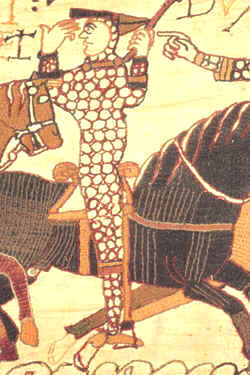The Bayeux Tapestry
The Bayeux Tapestry is a well known linen cloth embroidered with the events describing the Norman conquest of England, resulting in the Battle of Hastings. It measures almost 70 metres (230 ft) long and 50 centimetres (20 inches) high. The tapestry is named after Bayeux in normandy, France because this is where it has been kept ever since it was made.
The huge size of the Bayeux Tapestry sets it apart from others from the same era. The first written record of the Bayeux Tapestry was in 1476, when it was noted down in the cathedral treasury at Bayeux as "a very long and narrow hanging on which are embroidered figures and inscriptions comprising a representation of the conquest of England".
It was originally an even larger width but a section at the end has been removed at some point. The tapestry has a combination of images and Latin text, which tells the story of how Duke William of Normandy came to succeed Edward the Confessor as king of England.
The tapestry features five principal colours: light green, terracotta, blue-green, grey-blue and buff. There is also evidence of yellow, dark green and dark blue being used.
The Bayeux Tapestry has been a useful source for historians, who have used it to discover more about the events of the Battle of Hastings, as well as the viewpoint of those who witnessed it. However, as the tapestry was commissioned by the Normans, it paints a one-sided view of the event.
Although it is not known where exactly the tapestry was made, it is thought it could have been created by women in Canterbury, Kent, before being transported to France. Historians believe the Bishop of Odo of Bayeux commissioned the work to celebrate the battle, which his half-brother William won. Odo also had a connection to Kent - he was made Bishop of Kent after the battle - which makes it more likely that the tapestry was made there. Also, the spelling of the Latin used on the tapestry is typical of the English rather than the French.

The details of the soldiers in battle are extremely accurate, which leads historians to believe that the work was carried out by women who were advised by ex-soldiers.
The tapestry contains about 50 different scenes, each featuring people, animals and even mythical beasts. In fact, there are 55 dogs, 49 tress, 41 ships, 202 horses, 505 other creatures, and 37 buildings.
Some historians believe the tapestry is simply Norman propaganda supporting William’s invasion of England, but some parts of it are not very favourable towards the Normans. One section even shows Norman soldiers setting a home on fire as the terrified residents flee. The Domesday Book shows the amount of damage done to the area surrounding Hastings. The tapestry now attracts hundreds of visitors from across the world.
During the French Revolution soldiers planned to put the tapestry to a different use - to protect the contents of their wagons from the rain. Thankfully, a member of Bayeux city council, Lambert Leonard-Leforestier, jumped in at the last minute to save the tapestry.
The tapestry was given an official exhibition centre in 1949.
See also:
MLA Citation/Reference
"The Bayeux Tapestry". HistoryLearning.com. 2026. Web.
